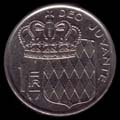Coins of Monaco in Euro and francs, with images, characteristics and history of the Monegasque currencies
 Monaco was settled by the Ligures, who emigrated from their native city
of Genoa, Italy. The local Hellenes referred to the Ligurians as Monoikos,
from the Greek the Greek Μόνοικος -
μόνος + οίκος,
"single house", which bears the sense of a people either settled
in a "single habitation" or of "living apart" from
others. The early history is primarily concerned with the protective and
strategic value of the Rock of Monaco, the area's chief geological landmark,
which served first as a shelter for ancient peoples and later as a fortress.
Monaco was settled by the Ligures, who emigrated from their native city
of Genoa, Italy. The local Hellenes referred to the Ligurians as Monoikos,
from the Greek the Greek Μόνοικος -
μόνος + οίκος,
"single house", which bears the sense of a people either settled
in a "single habitation" or of "living apart" from
others. The early history is primarily concerned with the protective and
strategic value of the Rock of Monaco, the area's chief geological landmark,
which served first as a shelter for ancient peoples and later as a fortress.
Phocaeans of Massalia founded the colony of Monoikos, named for its Ligurian inhabitants, in the 6th century b.C. Monoikos was associated with Hercules, venerated in this location alone as Hercules Monoecus.
Annnexed by Marseilles Monaco was Christianized in the 1st cent. a.D. After the Gallic Wars, Monoecus, which served as a stopping-point for Julius Caesar on his way to campaign in Greece, fell under Roman control as part of the province of Gallia Transalpina. Monaco remained under Roman control until the collapse of the Western Roman Empire in 476, from which point the area was ravaged by Saracens and various barbarian tribes.
In the 7th cent. it was part of the kingdom of the Lombards, and in the 8th cent. of the kingdom of Arles. It was under Muslim domination (8th cent.) after the Saracens invaded France. The Saracens were expelled in 975, and by the 11th century area was again populated by Ligurians.
In 1191, Holy Roman Emperor Henry VI granted suzerainty over the area to the city of Genoa, the native home of the Ligurians. On June 10, 1215, a detachment of Genoese Ghibellines led by Fulco del Cassello began the construction of a fortress atop the Rock of Monaco. This date is often cited as the beginning of Monaco's modern history.
As the Ghibellines intended their fortress to be a strategic military stronghold and center of control for the area, they set about creating a settlement around the base of the Rock to support the garrison; in an attempt to lure residents from Genoa and the surrounding cities, they offered land grants and tax exemption to new settlers.
The Grimaldis, descended from Otto Canella and taking their name from his son Grimaldo, were an ancient and prominent Guelphic Genoese family who, in the course of the civil strife in Genoa between the Guelphs and Ghibellines, took refuge in Monaco, accompanied by various other Guelphic families, most notably the Fieschis. François Grimaldi seized the Rock of Monaco in 1297.
In 1731 the male line died out, but the French Goyon-Matignon family, which succeeded by marriage, assumed the name Grimaldi. Monaco was under Spanish protection from 1542 to 1641, under French protection from 1641 to 1793, annexed to France in 1793, and under Sardinian protection by the Congress of Vienna from 1815 to 1861. The districts of Menton and Roquebrune (long part of Monaco) were incorporated (1848) into Sardinia, which in turn ceded them to France in 1860.
Monaco's sovereignty was confirmed by the Franco-Monegasque Treaty of 1861. Until 1911, when the first constitution was promulgated, the prince was an absolute ruler. The famous Casino of Monte Carlo opened in 1863; taxes paid by the Casino have been plowed into Monaco's infrastructure. Economic development was spurred in the late 19th century with a railroad linkup to France. In July 1918, a treaty was signed providing for limited French protection over Monaco. The treaty, included into the Treaty of Versailles, established that Monegasque policy would be aligned with French political, military, and economic interests.
Rainier III, succeeded his grandfather, Louis II, as ruler of Monaco in 1949. In 1956, Rainier married Grace Kelly (1929–82), an American motion-picture actress, and a male heir, Albert, was born in 1958. The current ruler, Prince Albert II, succeeded his father Prince Rainier III in 2005.
Due to the relationships with France, the pre euro currency in Monaco was
the French franc (FRF). The conversion between euro and franc was
settled to 1 euro = 6.55957 FRF.
links: Principality of Monaco, Musée
des Timbres et des Monnaies